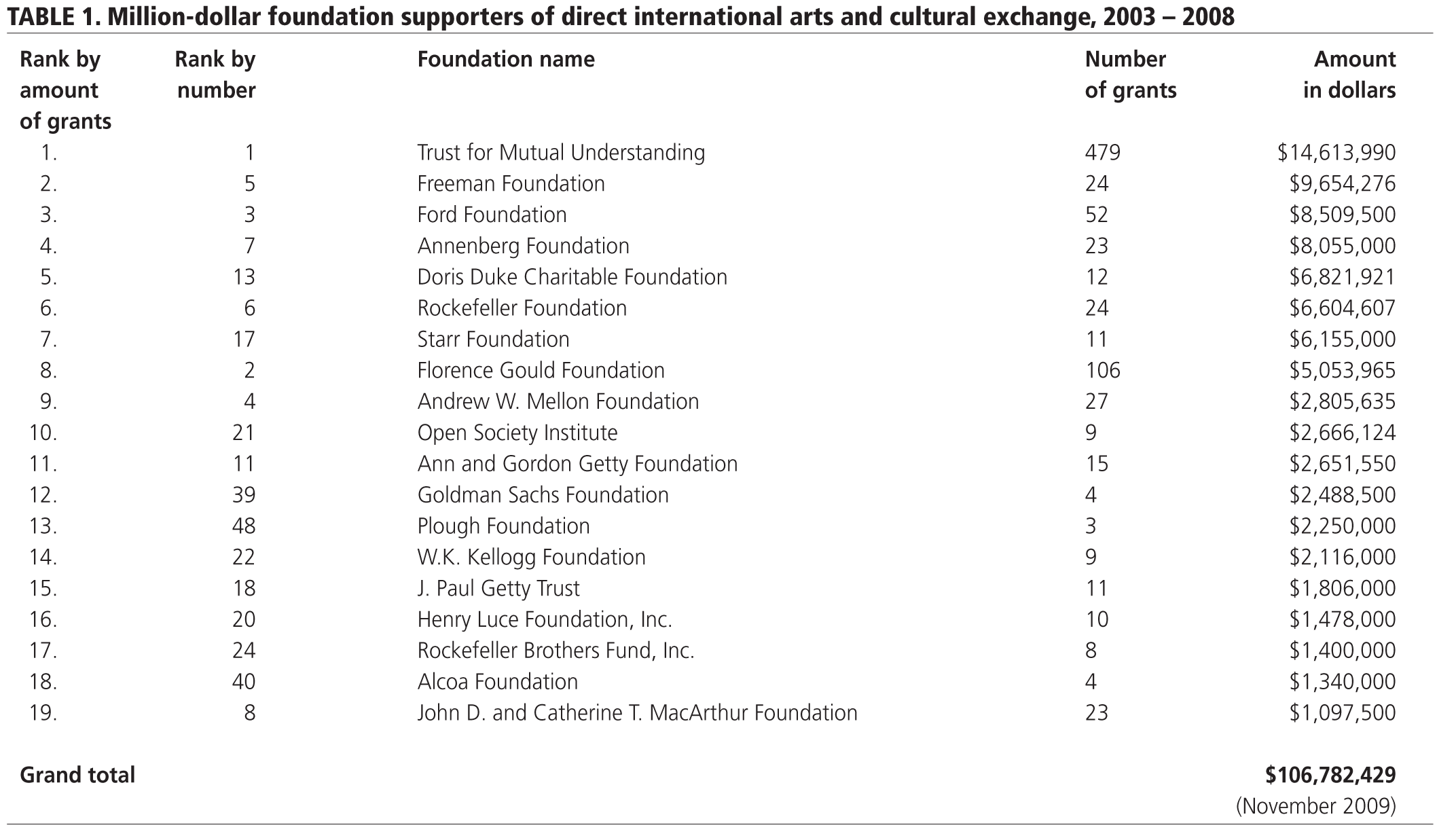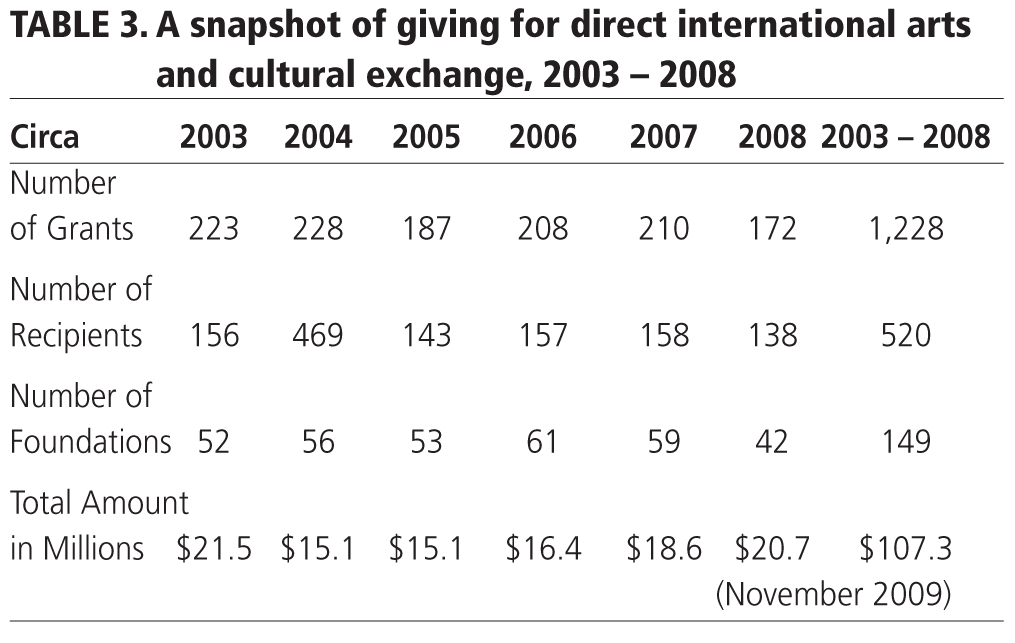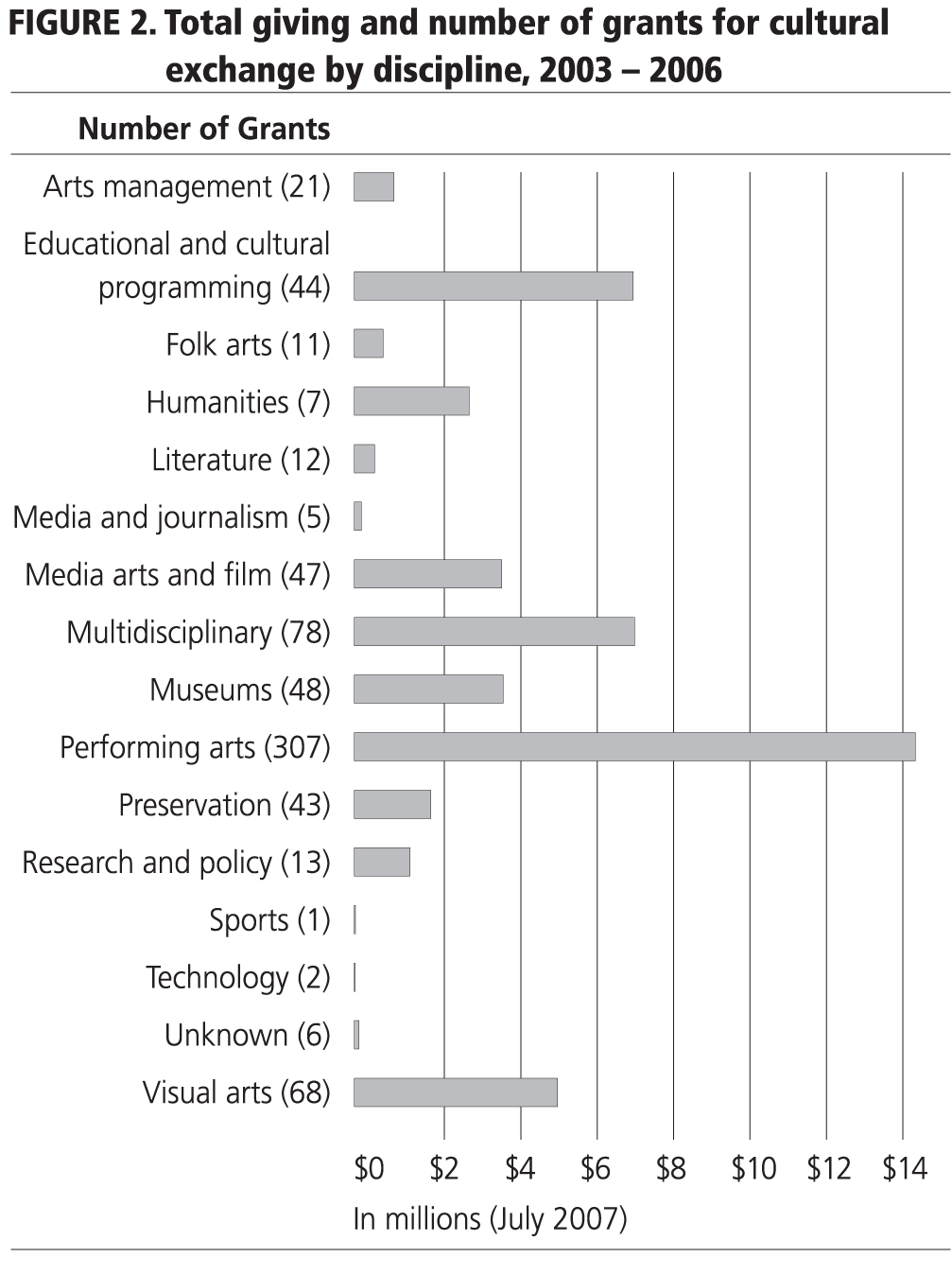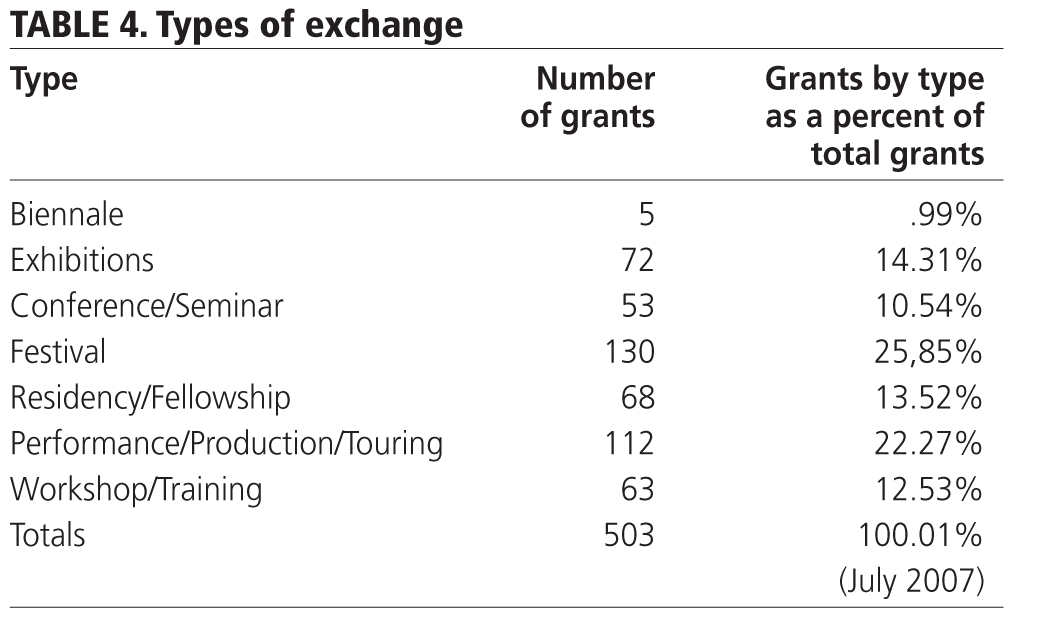Trends in Private Sector Giving for Arts and Cultural Exchange
In 2007, with the Bush administration’s aggressive foreign policy looming large in the world’s perception of the United States, the Robert Sterling Clark Foundation expanded its arts research agenda to include a major in-house project aimed at shedding light on the recent history of public and private support for international arts and cultural exchange as an instrument of public diplomacy. We at the foundation noted that the US Information Agency (USIA), created in 1953, eventually became the major player in the field, spending countless millions during the Cold War to project a positive image of the United States and the democratic principles upon which it was founded. But when the Berlin Wall came down in 1989 and the Soviet Union collapsed in 1991, the US government increasingly viewed expenditures for cultural exchange–based diplomacy as superfluous and subsequently reduced them. By the turn of the century, the USIA had been dismantled, its functions transferred to multiple agencies, and its few remaining arts exchange programs moved to the Department of State. From 2001 through 2008, State Department support for arts exchange (through the Bureau of Educational and Cultural Affairs) never exceeded $10 million a year and averaged considerably less on an annual basis during this period. (For further information on public sector funding, refer to Promoting Public and Private Reinvestment in Cultural Exchange–Based Diplomacy on the Robert Sterling Clark Foundation’s website at rsclark.org.)
On the private sector front, we found that foundation activity began to decline substantially following the turn of the century. It is to this subject we now turn.
Foundation Disinvestment in International Cultural Exchange, 2003–2008
In the summer of 2007, the Robert Sterling Clark Foundation commissioned data from the Foundation Center on grants over $10,000 appropriated from 2003 through 2006 with the primary classification of “Arts-related International Exchange” and “International Grants for Arts Policy.” These data were amplified by the use of the Foundation Center’s Foundation Directory Online subscription service in June 2008 to obtain further information on grants ($10,000 and above) appropriated by US foundations classified under the subject field of “International Exchange, Arts” for the years 2003 through 2006. In the fall of 2009, our research was again updated to include grants appropriated in the years 2007 and 2008. Altogether, 1,228 unique grants in support of direct international cultural exchange were appropriated by foundations from 2003 through 2008.1 These data inform the following report.
Giving for International Engagement Is Less Than 1 Percent of Total Arts Giving
It is estimated that in the 1990s, when foundations were most active in this field, investment in international arts and cultural exchange was approximately 1 percent of arts giving by the nation’s largest donors in this field.2 But in the post-9/11 environment, grant programs at many of the largest supporters began to contract, including those at Rockefeller and Ford. From 2003 through 2008, with arts giving totaling nearly $16 billion, grants for cultural exchange totaled $107 million, or only .68 percent of total arts giving. In fact, the only foundations that have provided sustained investment are the Trust for Mutual Understanding (TMU) and the Florence Gould Foundation. Founded in 1984, the TMU has supported this work for twenty-five years3 and has, on average, appropriated some $2.5 million for each of the past ten years to promote understanding and collaboration between Russia, Central and Eastern European nations, and the United States. The Florence Gould Foundation is an American foundation devoted to French-American exchange and understanding with levels of giving approaching $1 million per year. The following tables, which cover the period from 2003 through 2008, illustrate the realities confronted by US organizations and individual arts practitioners seeking funds for international cultural engagement.
Few Foundations Provide Meaningful Support
For the years 2003 through 2008, only nineteen foundations gave more than $1 million in total for international arts exchange. At the top of table 1 is the Trust for Mutual Understanding, which awarded 479 grants totaling nearly $15 million for programs related to Russia and Eastern Europe. Members of the Rockefeller family fund the trust, and the patterns of the TMU’s giving reflect political concerns that emerged during the Cold War era. In addition to the TMU, the Annenberg Foundation, the Doris Duke Foundation for Islamic Art, the Florence Gould Foundation, the Andrew W. Mellon Foundation, the Rockefeller Brothers Fund, and the Starr Foundation all continue to provide support in the field.
Large Foundations with Historical Commitments to International Engagement Leave Field
Table 2 shows that only nineteen foundations in the United States gave more than $100,000 in support of international arts exchange in 2008. This figure is reflective of the fact that many of the larger foundations, including those with historical commitments to international arts and cultural exchange, have shifted their priorities in recent years. A comparison of this table with table 1 presented reveals that many of the large foundations that show up as “Million Dollar Donors” over the period 2003–2008 are no longer providing support in 2008, or are providing substantially less support than in earlier years. These include the Freeman, Ford, Rockefeller, MacArthur, and Ann and Gordon Getty foundations, as well as the Open Society Institute.
Ford and Rockefeller, two foundations with long historical commitments to international arts and cultural exchange, have left the field. By 2003, the Rockefeller Foundation, the once great partner of the federal government in supporting public-private international partnerships, had begun to wind down its international investment in the arts. Similarly, by 2005, the Ford Foundation ended its ten-year initiative to internationalize work in the performing arts. Sadly, the MacArthur Foundation is eliminating its support for local-international art partnerships after a brief, two-year commitment. Grants made by the remaining foundations represent, as far as we can tell, one-time or nonprogrammatic expenditures. A few represent new initiatives.
Disinvestment in the Field Over Time as Measured by Number of Grants, Number of Foundations, and Number of Recipients
Altogether, some 1,228 grants for international arts exchange made by 149 foundations were reported to the Foundation Center Grants Index over the eight-year study period. Table 3 shows a decline in all categories (number of grants, number of recipients, and number of foundations), indicating a persistent decline in international arts and cultural exchange activity. The one slightly encouraging aspect of our findings is that after reaching a low point in 2005, foundation giving has begun to creep up from 2006 through 2008. Nevertheless, the amounts given represent a minuscule amount compared with the $15.75 billion that was granted for the arts between 2003 and 2008.
We began this section of the report by noting that foundations were more active in the field of international cultural exchange in the 1990s. In 1994 a report was published by Jane Alexander, then chair of the National Endowment for the Arts, titled World Arts: A Guide to International Arts Exchange. Created as a resource for artists and organizations interested in participating in international engagement, the guide listed a variety of resources, including some fifty-one private and corporate foundations that provided financial support for international arts exchange. As part of our report, we researched each of them on the Internet or by telephone. Of the fifty-one foundations listed, thirty-two no longer provide support in the field. This represents a decline of 64.8 percent over the fifteen-year period between 1994 and 2009.
Characteristics of Grant Recipients
Geographic Distribution: International Giving Reflects Cold War Priorities
Recent international arts grantmaking does not appear to reinforce US diplomacy in areas of the world that are strategically important to the United States. Rather, foundation funding remains committed to projects in Europe and Asia, many of which are reflective of Cold War priorities or the discrete regional interest of a particular donor. It should be noted in figure 1 that the geographic region “Europe” includes Russia. The numbers shown closely reflect the activities of the Trust for Mutual Understanding, which, as reported earlier, accounts for 479 grants totaling $14,613,990 or 59 percent of all funding for this region. Excluding the TMU’s grantmaking, which is geographically limited to US arts and cultural exchanges involving Russia and nations formerly behind the Iron Curtain, projects targeting Asia received the most foundation support. It should be noted that, with the exception of the Doris Duke Foundation for Islamic Art and the Islamic Initiatives Project at the Carnegie Corporation, most foundations are not engaged in major efforts to encourage arts and cultural exchanges between the United States and the Middle East or the Islamic world, which are of such importance to the United States.
Disciplinary Distribution: Performing Arts and Multidisciplinary Activities Attract Donors
Figure 2 shows the total amount granted in the disciplinary categories reported to the Foundation Center and included in the Grants Index for the years 2003 – 2006.
The majority of grant funds awarded in support of cultural engagement fell into three categories: the performing arts, multidisciplinary activities, and educational and cultural programming. Altogether, the amount granted in the performing arts totaled nearly $14 million. On the whole, foundations appear to support the “elite performing arts.” The result is that the cultural programming exported to other countries or brought into the United States frequently overlooks the presentation of diverse cultural expressions.
Types of Exchange: Performances and Productions at Festivals Attract Donors
Most grants for international arts and cultural exchange, for which a purpose could be identified, were in support of performances or productions, usually presented through festivals or exhibitions (see table 4). Because these categories of exchange overlap to such a high degree, we have aggregated the data. Collectively, these categories account for 62.43 percent of our total.
Size of Recipients: Larger and More Established Organizations Command the Greatest Share
Most of the organizations supported for international arts exchange are major US arts institutions (Asia Society, National Gallery of Art, and the Sundance Institute). Other recipients are not only large but have been engaged in a variety of international activities in addition to the arts. These are frequently supported by foundations that fund internationally in specific regions of the world and include organizations such as the China Institute, the Russian Arts Foundation, and French American Cultural Exchange. Still others, including the Asian Cultural Council and CEC ArtsLink, have been in the business of operating exchange programs for decades and have established strong track records in the field. Thus, it appears that foundation support accrues to arts and cultural institutions that are prestigious, have long track records, and are more traditional in their roles as presenters and educators.
Opportunities for Foundation Investment in International Arts Engagement
- Foundations can take the lead in developing partnerships with public sector agencies such as the State Department and the National Endowment for the Arts.
- Foundations can develop partnerships with corporate sector organizations to leverage corporate giving such as Business for Diplomatic Action and the Conference Board.
- Partnerships among foundations should be explored:
- Grantmakers in the Arts should spearhead the development of “foundation consortia” that would serve to aggregate support for work in this field.
- Grantmakers in the Arts should test its ambitions to become an “arts advocate” by helping to establish “international cultural engagement” as an issue of importance to the field.
A Place in the Sun for Foundations Seeking Impact
As we have seen, there has been a staggering degree of disinvestment on the part of the public and private sectors in the field of international arts exchange and exchange-based diplomacy.
We are hopeful that forward-thinking foundations will be interested in participating in the reconfiguration of a field that has been left with little structure. The opportunity to help in shaping its parameters through constructive reinvestment and creative thinking is enormous.
Notes
- Grants from the Foundation Center database were analyzed by our consultant, Aimee R. Fullman.
- András Szántó, “A New Mandate for Philanthropy” (Washington, D.C.: Center for Arts and Culture, 2003).
- The Trust for Mutual Understanding has been providing support in this field for the past twenty-five years. Total giving for 1985 through 1997 was $16,617,222 and averaged $1,278,241 per year.






